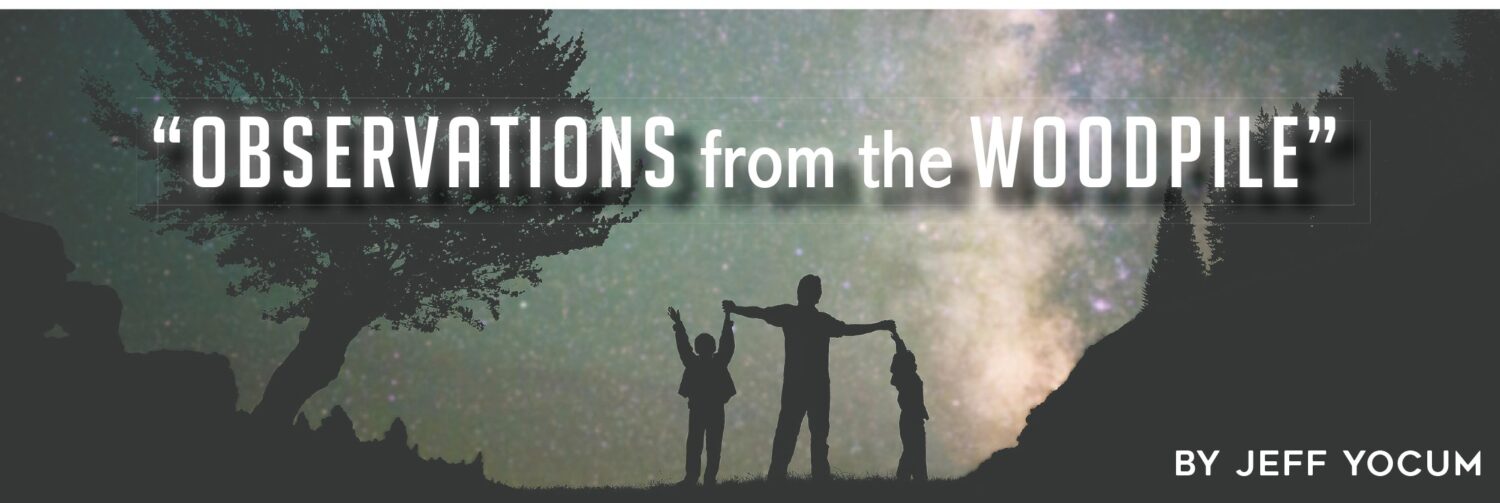
“Observations from the Woodpile”

Prologue
Observations from the Woodpile” is a collection of essays bundled together and given as a birthday present for my wife, Nancy, in 1997. Twenty-seven years have passed since the collection was given. The two main subjects of the essays, my sons Justus and Jacob, have grown into men with families of their own.
Knots
I buy my firewood logs from a fellow with a small logging business. There is seldom a log that has much value as a saw log. For the most part, the logs I get are knotty or forked or have other imperfections that downgrade the value to pulpwood or firewood. That’s okay by me. I’d hate to see any wood that could be used as lumber go up in smoke.
The downside to this is the difficulty in cutting and splitting around the knots and other imperfections. Splitting a knot by hand is not easy. The grain of the wood twists itself around in every direction to where it looks like it has tied itself into some sort of a sailor’s knot. However, there are ways to get around splitting the knot.
When sawing a log into firewood lengths, I try to get as many clear, knot-free pieces as possible. The boys love to split those. They yield so easily with just a few whacks. Sometimes, I cut the log from both ends to isolate the knot somewhere in the middle. This sometimes leaves me with a short chunk that will fit into the stoves without splitting. By the time all the logs are split, I end up with about half of a pickup load of these pieces. They don’t stack as well, but they burn just fine. I usually pile them up in a corner of the barn—like lumps of coal—and burn them along with the regular wood throughout the winter.
Sometimes, the knot or fork is a little bigger. I try to split as much away from the knot as possible. This usually leaves a piece of wood that’s a little larger than the rest. I scatter these pieces through the stacks in the woodshed. Doing this makes them available every so often as I work through the stacks of wood. They tend to burn slower and are particularly good for those brutal, cold nights.
My favorite trick is to measure out my cuts so that one of the cuts falls directly on a knot. By doing so, I have made two half-knots. Two half-knots are easier to split than one whole knot. A military history buff will recognize this trick as “defeat enemy in detail.” Napoleon was a master at the tactic. Stonewall Jackson employed it in his successful defense of the Shenandoah Valley. And there’s a little taste of victory whenever I defeat a knot.
At the end of a wood-splitting day, there’s always one or two pieces left that just aren’t going to split. I call these the Gordian knots. The solution to these is the same as Alexander the Great’s—just cut them. I don’t like doing that because it’s that much more wear and tear on the saw, but it’s the only way some wood will split. If I didn’t do that, over time, I’d end up with a pile of wood I couldn’t use.
Occasionally, I get a piece of wood that is just not worth the effort and expense. The log might be just one big, twisted knot or there might be some metal object embedded in the wood, waiting to tear my saw apart, or some other anomaly. These logs are dragged off to the corner of the property and used for campfire wood.
I don’t have much real use for campfire wood just a few hundred yards from my house. Having this derelict wood provides an excuse for a campfire, though. Some twilight winter evenings when the wind is not too brisk and cabin fever has caused the walls to close in, I’ll build a fire along an old stone wall. I tell everyone I’m burning some brush. After all, sitting around outside would be crazy. The boys usually join me after a while and poke sticks into the fire. Pyromania must be primordial. Sometimes, we talk. Sometimes, we stare, mesmerized by the dynamics of the flames and coals. No television. No phone. No radio. Just us and our thoughts. Something about a fire nurtures contemplation.
When contemplation is about problem-solving, the solutions are not much different than handling knots. Some just need to be cut around until they are minimized away. Some need to be broken down into smaller, more manageable problems. Bigger problems need a direct approach, requiring considerably more energy and resources. They are particularly wearing, but a successful outcome is worth the effort and expense. Some problems are best left alone. Walking away is sometimes the best solution.
The wisdom and the clarity to discern what kind of problem you have is the issue. That’s the time when there’s nothing better than the hypnotic dance of a campfire to sort out the knots.
